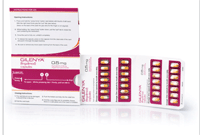 As primary eye care practitioners, we are often the first to detect the clinical signs of multiple sclerosis (MS); unilateral optic neuritis is the presenting sign in 20% of MS cases.1 MS was first described in 1868 by Jean-Martin Charcot, M.D., who noted that inflammatory cells distributed throughout the brain and spinal cord white matter were visible in patients with episodes of neurological dysfunction.
As primary eye care practitioners, we are often the first to detect the clinical signs of multiple sclerosis (MS); unilateral optic neuritis is the presenting sign in 20% of MS cases.1 MS was first described in 1868 by Jean-Martin Charcot, M.D., who noted that inflammatory cells distributed throughout the brain and spinal cord white matter were visible in patients with episodes of neurological dysfunction.
MS is the most common, non-traumatic, debilitating neurological disease in young adults between the ages of 20 and 40. The disease demographics include a 2:1 female to male ratio that affects up to 2.5 million people worldwide, with 50% needing some type of assistance while walking within 15 years after the onset of the disease.2-5 While the exact cause remains unknown, it is theorized that MS is an autoimmune disease, coupled with genetic predisposition and environmental factors.
 Introducing Gilenya
Introducing Gilenya
Until recently, all disease-modifying medications for MS were delivered subcutaneously or intramuscularly—including interferon-B, glatiramer acetate, mitoxantrone and natalizumab, with daily to weekly dosing schedules.
Gilenya (fingolimod 0.5%, Novartis) is the first FDA-approved oral, once daily first line agent for relapsing forms of MS. Gilenya is indicated to reduce the frequency of clinical exacerbations and to delay the accumulation of physical disability in patients with relapsing forms of MS.
Fingolimod is a sphingosine-1-phosphate receptor modulator that prevents the egress of lymphocytes from lymph nodes. This leads to the entrapment of CD4+ and CD8+ T cells and B cells in secondary lymphatic organs, preventing these aggressive lymphocytes from infiltrating the central nervous system.6-7
The availability of a more convenient, efficacious and safe drug as an alternative to self-injectable medications could be a tremendous asset to a patient with MS. Adherence to therapy is always an issue with a chronic illness, especially when the treatment involves extensive time, expense and discomfort.8,9 Additionally, anxiety can be a barrier to self-injection, reducing the effectiveness of treatment.10 Improved patient compliance naturally confers improved patient health.
The Research: FREEDOMS
The FTY720 Research Evaluating Effects of Daily Oral Therapy in Multiple Sclerosis (FREEDOMS) study was a Phase III, 24-month, double-blind, placebo-controlled, randomized study of 1,272 MS patients between the ages of 18 and 55, with relapsing-remitting MS.11 Patients received either oral fingolimod at a dose of 0.5mg or 1.25mg daily, or a placebo.
The primary endpoint was the annualized relapse rate—number of confirmed relapses per year. The main secondary endpoint was the time to disability progression, confirmed after three months, and defined as an increase of one point on the Expanded Disability Status Scale (EDSS)—the range is from 0 to 10, with higher scores indicative of greater disability. Participants had to have an initial score below six, indicating that they are ambulatory without support. Additional secondary endpoints included time to first relapse, time to disability progression as confirmed after six months, MRI measures, and safety and tolerability measures. A total of 1,033 (81.2%) patients completed the study.11
For the primary outcome, there was annualized relapse rate of 0.18 in the 0.5mg fingolimod group, 0.16 in the 1.25mg fingolimod group and 0.40 in the placebo group (p<0.001 for either fingolimod dose vs. placebo). For the secondary endpoint, there was significant reduction in the risk of disability progression at both dose levels of fingolimod compared to placebo, as well as superiority over placebo for the additional secondary endpoints.
The incidence of adverse events was similar in all groups (10.1% to 13.4%) and included bradycardia and atrioventricular conduction block at initiation, macular edema, elevated liver enzyme levels and mild hypertension; these incidents were more commonly associated with the higher level dose of fingolimod.
Of significance to optometrists and ophthalmologists is the fact that macular edema was found in seven patients taking the 1.25mg dose, with five of the cases occurring within three months of initiating therapy and six cases resolved within one to six months after discontinuation of the drug.
The Research: TRANSFORMS
The Trial Assessing Injectable Interferon versus FTY720 Oral in Relapsing-Remitting Multiple Sclerosis (TRANSFORMS) study was a 12-month, double-blind, double-dummy randomized study of 1,292 patients between the ages of 18 to 55, with relapsing-remitting MS with a recent history of at least one relapse.12 Participants had to have an initial EDSS score below six, indicating that they are ambulatory without support.
Patients received either daily oral fingolimod 0.5mg or 1.25mg, or intramuscular interferon beta-1a (IFN-B1a) at a weekly dose of 30µg. The primary endpoint was the annualized relapse rate, with key secondary endpoints being the number of new or enlarged lesions on T2-weighted MRI scans at 12 months and progression of disability that was sustained for at least three months. A total of 1,153 (89.2%) patients completed the study.
The annualized relapse rate was significantly lower in both fingolimod groups than the IFN-B1a group, though there was no difference in disability progression between the groups—possibly due to the short duration of the study. There was improvement in MRI measures and brain volume loss with both fingolimod doses as compared to IFN-B1a. Adverse events were greater in the 1.5mg fingolimod group (10.7%) than the 0.5mg group (7%) of the IFN-B1a group. There were two deaths from herpes infections.
Overall, macular edema was confirmed in 13 patients; 11 of whom received the higher fingolimod dose (seven in the FREEDOMS trial, four in the TRANSFORMS trial). Eleven patients recovered within one to six months of discontinuation of the drug, and the remaining two patients remained stable. However, the manufacturer recommends that patients undergo a baseline ophthalmological exam every three to six months while on treatment. There is no mention of how the edema was detected in the trials, or how it should be assessed and monitored while on treatment. The practitioner can determine how to proceed, using either serial dilated fundus examinations or optical coherence tomographies.
The introduction of an oral agent is an exciting breakthrough treatment for our MS patients and has the potential for enhanced convenience, improved compliance with treatment and reduction of undesirable injection site effects.13 Particularly due to the concern of macular edema, the eye care practitioner will be an integral part of the MS management team as we are called upon to monitor our patients’ ophthalmologic status during the course of treatment.
1. Atkins E. Optic Neuritis and MS. Multiple Sclerosis Foundation. 2009 Jul. Available at:
www.msfacts.org/article-details.aspx?articleID=380 (accessed August 2011).
2. Ehling R. Berger T, Reindl. Multiple Sclerosis – established and novel therapeutic approaches. Cent Nerv Syst Agents Med Chem. 2010 Mar;10(1):3-15.
3. Compston A, Coles A. Multiple Sclerosis. Lancet. 2008 Oct 25;372(9648):1502-17.
4. Weinshenker BG, Bass B, Rice GP, et al. The natural history of multiple sclerosis: a geographically based study. 2. Predictive value of the early clinical course. Brain. 1989 Dec;112 (Pt 6):1419-28.
5. Noseworthy JH, Lucchinetti C, Rodriguez M, Weinshenker BG. Multiple Sclerosis. N Engl J Med. 2000 Sep 28;343(13):938-52.
6. Matloubian M, Lo CG, Cinamon G, et al. Lymphocyte regress from thymus and peripheral lymphoid organs is dependent on S1P receptor 1. Nature. 2004 Jan 22;427(6972):355-60.
7. Compston A, Coles A. Multiple sclerosis. Lancet. 2008 Oct 25:372(9648):1502-17.
8. Cramer JA. Partial medication compliance: the enigma in poor medical outcomes. Am J Manag Care. 1995;1:45-52.
9. Samuel L, Lowenstein EJ. Recurrent injection site reactions from interferon beta 1-b. J Drugs Dermatol. 2006 Apr;5(4):366-7.
10. Mohr DC, Boudewyn AC, Likowsky W, et al. Injectable medication for the treatment of multiple sclerosis: the influence of expectations and injection anxiety on adherence and ability to self-inject. Ann Behav Med. 2001 Spring;23(2):125-32.
11. Kappos L, Radue Ernst-Wilhelm, O’Connor P, et al. A placebo-controlled trial of oral fingolimod in relapsing multiple sclerosis. N Engl J Med. 2010 Feb;362(5):387-401.
12. Cohen JA, Barkhof F, Comi G, et al. Oral fingolimod for intramuscular interferon for relapsing multiple sclerosis. N Engl J Med. 2010 Feb 4;362(5):402-15.
13. Cohen B, Rieckmann P. Emerging oral therapies for multiple sclerosis. Int J Clin Pract. 2007 Nov;61(11):1922-30.


